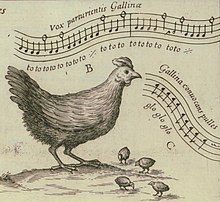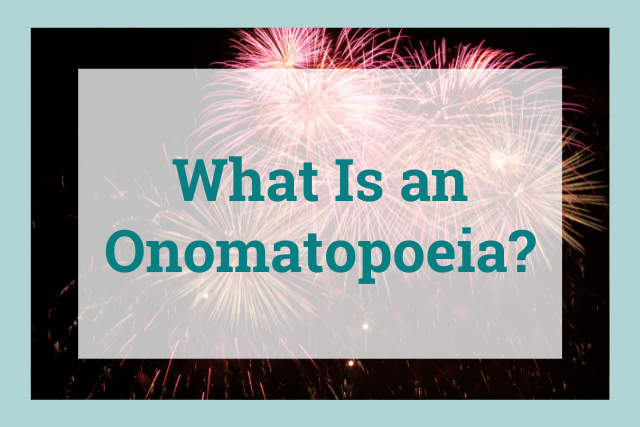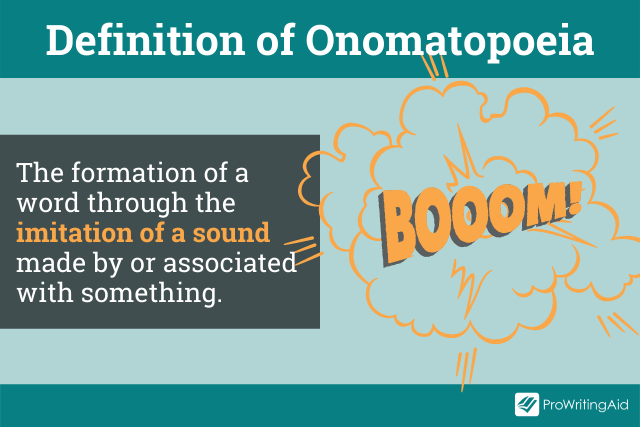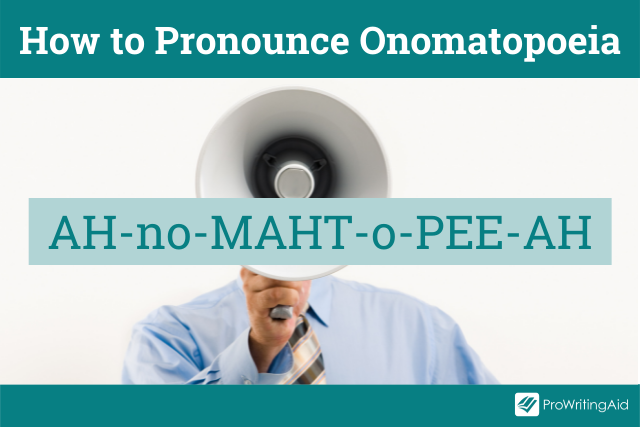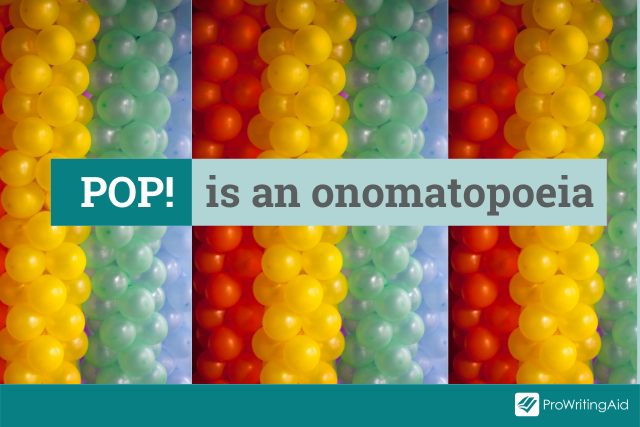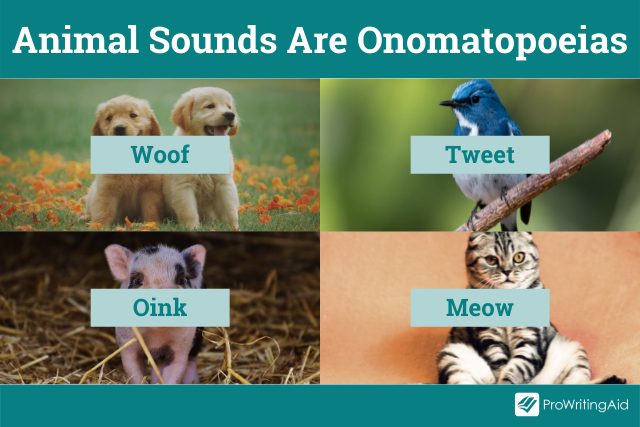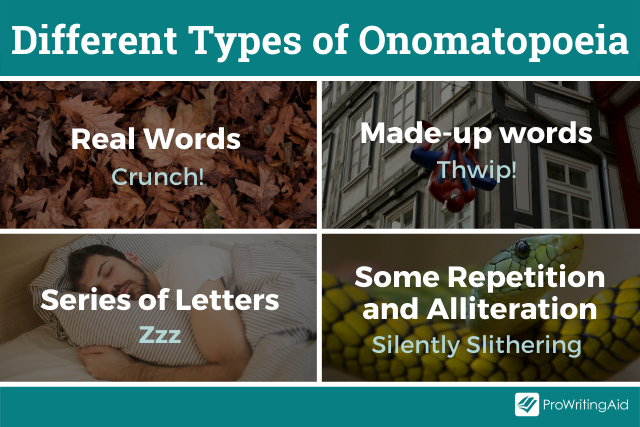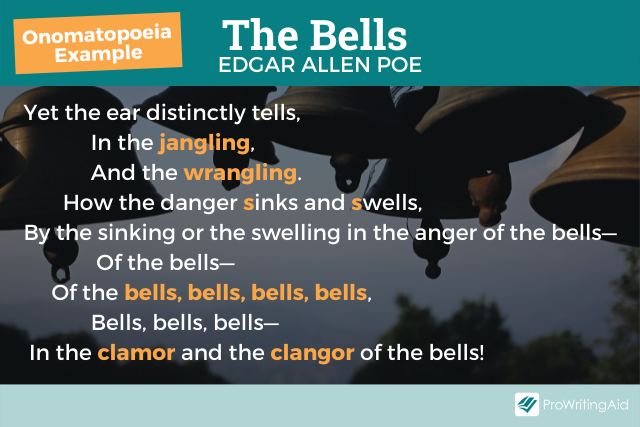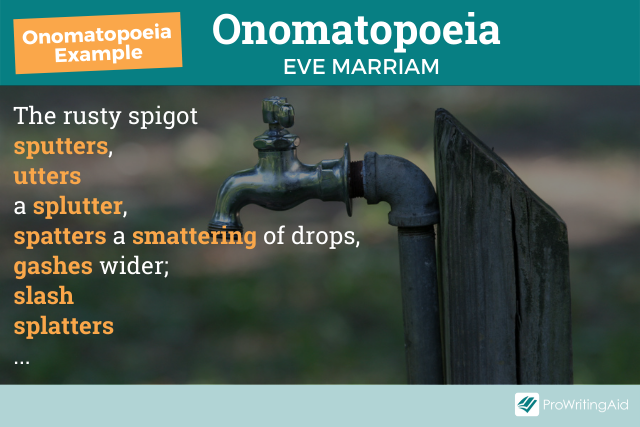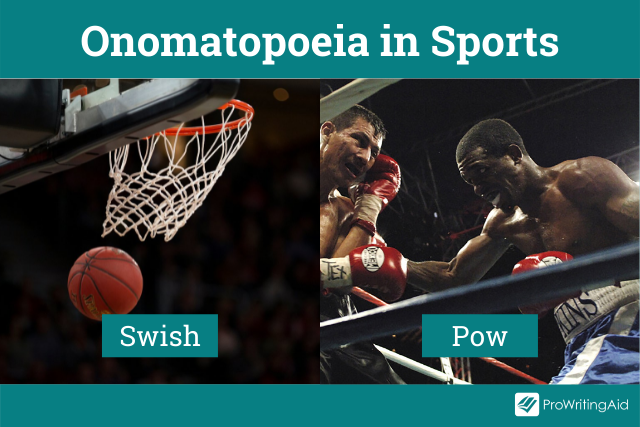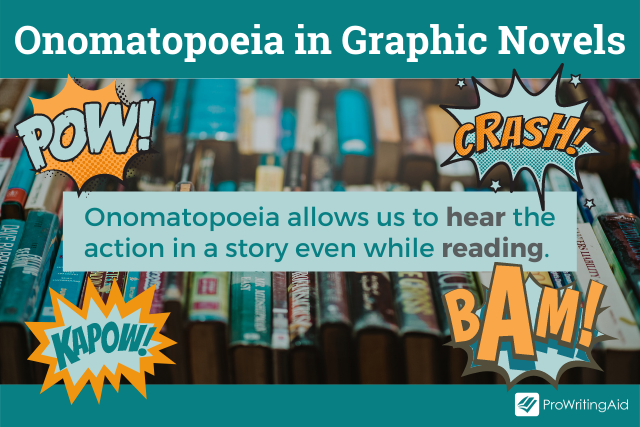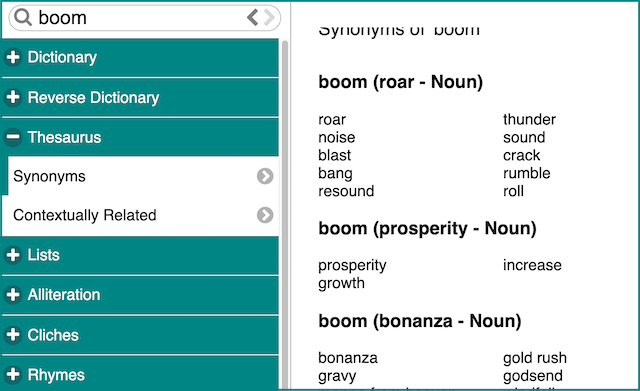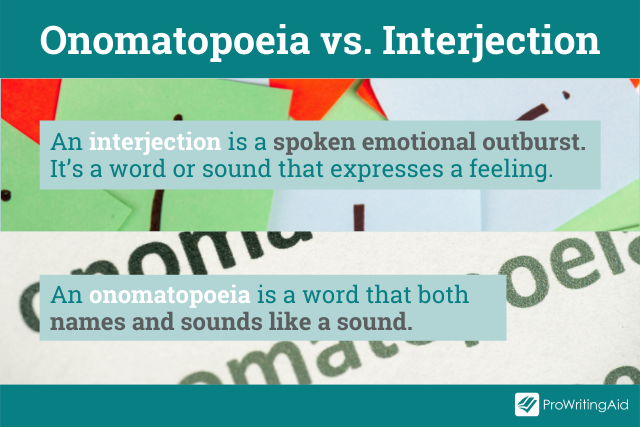A sign in a shop window in Italy proclaims these silent clocks make «No Tic Tac» [sic], in imitation of the sound of a clock.
Onomatopoeia[note 1] is the use or creation of a word that phonetically imitates, resembles, or suggests the sound that it describes. Such a word itself is also called an onomatopoeia. Common onomatopoeias include animal noises such as oink, meow (or miaow), roar, and chirp. Onomatopoeia can differ between languages: it conforms to some extent to the broader linguistic system;[6][7] hence the sound of a clock may be expressed as tick tock in English, tic tac in Spanish and Italian (shown in the picture), dī dā in Mandarin, kachi kachi in Japanese, or tik-tik in Hindi.
The English term comes from the Ancient Greek compound onomatopoeia, ‘name-making’, composed of onomato— ‘name’ and —poeia ‘making’. Thus, words that imitate sounds can be said to be onomatopoeic or onomatopoetic.[8]
Uses
According to Musurgia Universalis (1650), the hen makes «to to too», while chicks make «glo glo glo».
In the case of a frog croaking, the spelling may vary because different frog species around the world make different sounds: Ancient Greek brekekekex koax koax (only in Aristophanes’ comic play The Frogs) probably for marsh frogs; English ribbit for species of frog found in North America; English verb croak for the common frog.[9]
Some other very common English-language examples are hiccup, zoom, bang, beep, moo, and splash. Machines and their sounds are also often described with onomatopoeia: honk or beep-beep for the horn of an automobile, and vroom or brum for the engine. In speaking of a mishap involving an audible arcing of electricity, the word zap is often used (and its use has been extended to describe non-auditory effects of interference).
Human sounds sometimes provide instances of onomatopoeia, as when mwah is used to represent a kiss.[10]
For animal sounds, words like quack (duck), moo (cow), bark or woof (dog), roar (lion), meow/miaow or purr (cat), cluck (chicken) and baa (sheep) are typically used in English (both as nouns and as verbs).
Some languages flexibly integrate onomatopoeic words into their structure. This may evolve into a new word, up to the point that the process is no longer recognized as onomatopoeia. One example is the English word bleat for sheep noise: in medieval times it was pronounced approximately as blairt (but without an R-component), or blet with the vowel drawled, which more closely resembles a sheep noise than the modern pronunciation.
An example of the opposite case is cuckoo, which, due to continuous familiarity with the bird noise down the centuries, has kept approximately the same pronunciation as in Anglo-Saxon times and its vowels have not changed as they have in the word furrow.
Verba dicendi (‘words of saying’) are a method of integrating onomatopoeic words and ideophones into grammar.
Sometimes, things are named from the sounds they make. In English, for example, there is the universal fastener which is named for the sound it makes: the zip (in the UK) or zipper (in the U.S.) Many birds are named after their calls, such as the bobwhite quail, the weero, the morepork, the killdeer, chickadees and jays, the cuckoo, the chiffchaff, the whooping crane, the whip-poor-will, and the kookaburra. In Tamil and Malayalam, the word for crow is kaakaa. This practice is especially common in certain languages such as Māori, and so in names of animals borrowed from these languages.
Cross-cultural differences
Although a particular sound is heard similarly by people of different cultures, it is often expressed through the use of different consonant strings in different languages. For example, the snip of a pair of scissors is cri-cri in Italian,[11] riqui-riqui in Spanish,[11] terre-terre[11] or treque-treque[citation needed] in Portuguese, krits-krits in modern Greek,[11] cëk-cëk in Albanian,[citation needed] and katr-katr in Hindi.[citation needed] Similarly, the «honk» of a car’s horn is ba-ba (Han: 叭叭) in Mandarin, tut-tut in French, pu-pu in Japanese, bbang-bbang in Korean, bært-bært in Norwegian, fom-fom in Portuguese and bim-bim in Vietnamese.[citation needed]
Onomatopoeic effect without onomatopoeic words
An onomatopoeic effect can also be produced in a phrase or word string with the help of alliteration and consonance alone, without using any onomatopoeic words. The most famous example is the phrase «furrow followed free» in Samuel Taylor Coleridge’s The Rime of the Ancient Mariner. The words «followed» and «free» are not onomatopoeic in themselves, but in conjunction with «furrow» they reproduce the sound of ripples following in the wake of a speeding ship. Similarly, alliteration has been used in the line «as the surf surged up the sun swept shore …» to recreate the sound of breaking waves in the poem «I, She and the Sea».
Comics and advertising
A sound effect of breaking a door
Comic strips and comic books make extensive use of onomatopoeia. Popular culture historian Tim DeForest noted the impact of writer-artist Roy Crane (1901–1977), the creator of Captain Easy and Buz Sawyer:
- It was Crane who pioneered the use of onomatopoeic sound effects in comics, adding «bam,» «pow» and «wham» to what had previously been an almost entirely visual vocabulary. Crane had fun with this, tossing in an occasional «ker-splash» or «lickety-wop» along with what would become the more standard effects. Words as well as images became vehicles for carrying along his increasingly fast-paced storylines.[12]
In 2002, DC Comics introduced a villain named Onomatopoeia, an athlete, martial artist, and weapons expert, who often speaks pure sounds.[clarification needed]
Advertising uses onomatopoeia for mnemonic purposes, so that consumers will remember their products, as in Alka-Seltzer’s «Plop, plop, fizz, fizz. Oh, what a relief it is!» jingle, recorded in two different versions (big band and rock) by Sammy Davis, Jr.
Rice Krispies (US and UK) and Rice Bubbles (AU)[clarification needed] make a «snap, crackle, pop» when one pours on milk. During the 1930s, the illustrator Vernon Grant developed Snap, Crackle and Pop as gnome-like mascots for the Kellogg Company.
Sounds appear in road safety advertisements: «clunk click, every trip» (click the seatbelt on after clunking the car door closed; UK campaign) or «click, clack, front and back» (click, clack of connecting the seat belts; AU campaign) or «click it or ticket» (click of the connecting seat belt, with the implied penalty of a traffic ticket for not using a seat belt; US DOT (Department of Transportation) campaign).
The sound of the container opening and closing gives Tic Tac its name.
Manner imitation
In many of the world’s languages, onomatopoeic-like words are used to describe phenomena beyond the purely auditive. Japanese often uses such words to describe feelings or figurative expressions about objects or concepts. For instance, Japanese barabara is used to reflect an object’s state of disarray or separation, and shiiin is the onomatopoetic form of absolute silence (used at the time an English speaker might expect to hear the sound of crickets chirping or a pin dropping in a silent room, or someone coughing). In Albanian, tartarec is used to describe someone who is hasty. It is used in English as well with terms like bling, which describes the glinting of light on things like gold, chrome or precious stones. In Japanese, kirakira is used for glittery things.
Examples in media
- James Joyce in Ulysses (1922) coined the onomatopoeic tattarrattat for a knock on the door.[13] It is listed as the longest palindromic word in The Oxford English Dictionary.[14]
- Whaam! (1963) by Roy Lichtenstein is an early example of pop art, featuring a reproduction of comic book art that depicts a fighter aircraft striking another with rockets with dazzling red and yellow explosions.
- In the 1960s TV series Batman, comic book style onomatopoeic words such as wham!, pow!, biff!, crunch! and zounds! appear onscreen during fight scenes.
- Ubisoft’s XIII employed the use of comic book onomatopoeic words such as bam!, boom! and noooo! during gameplay for gunshots, explosions and kills, respectively. The comic-book style is apparent throughout the game and is a core theme, and the game is an adaptation of a comic book of the same name.
- The chorus of American popular songwriter John Prine’s song «Onomatopoeia» incorporates onomatopoeic words: «Bang! went the pistol», «Crash! went the window», «Ouch! went the son of a gun».
- The marble game KerPlunk has an onomatopoeic word for a title, from the sound of marbles dropping when one too many sticks has been removed.
- The Nickelodeon cartoon’s title KaBlam! is implied to be onomatopoeic to a crash.
- Each episode of the TV series Harper’s Island is given an onomatopoeic name which imitates the sound made in that episode when a character dies. For example, in the episode titled «Bang» a character is shot and fatally wounded, with the «Bang» mimicking the sound of the gunshot.
- Mad Magazine cartoonist Don Martin, already popular for his exaggerated artwork, often employed creative comic-book style onomatopoeic sound effects in his drawings (for example, thwizzit is the sound of a sheet of paper being yanked from a typewriter). Fans have compiled The Don Martin Dictionary, cataloging each sound and its meaning.
Cross-linguistic examples
In linguistics
A key component of language is its arbitrariness and what a word can represent,[clarification needed] as a word is a sound created by humans with attached meaning to said sound.[15] No one can determine the meaning of a word purely by how it sounds. However, in onomatopoeic words, these sounds are much less arbitrary; they are connected in their imitation of other objects or sounds in nature. Vocal sounds in the imitation of natural sounds doesn’t necessarily gain meaning, but can gain symbolic meaning.[clarification needed][16] An example of this sound symbolism in the English language is the use of words starting with sn-. Some of these words symbolize concepts related to the nose (sneeze, snot, snore). This does not mean that all words with that sound relate to the nose, but at some level we recognize a sort of symbolism associated with the sound itself. Onomatopoeia, while a facet of language, is also in a sense outside of the confines of language.[17]
In linguistics, onomatopoeia is described as the connection, or symbolism, of a sound that is interpreted and reproduced within the context of a language, usually out of mimicry of a sound.[18] It is a figure of speech, in a sense. Considered a vague term on its own, there are a few varying defining factors in classifying onomatopoeia. In one manner, it is defined simply as the imitation of some kind of non-vocal sound using the vocal sounds of a language, like the hum of a bee being imitated with a «buzz» sound. In another sense, it is described as the phenomena of making a new word entirely.
Onomatopoeia works in the sense of symbolizing an idea in a phonological context, not necessarily constituting a direct meaningful word in the process.[19] The symbolic properties of a sound in a word, or a phoneme, is related to a sound in an environment, and are restricted in part by a language’s own phonetic inventory, hence why many languages can have distinct onomatopoeia for the same natural sound. Depending on a language’s connection to a sound’s meaning, that language’s onomatopoeia inventory can differ proportionally. For example, a language like English generally holds little symbolic representation when it comes to sounds, which is the reason English tends to have a smaller representation of sound mimicry then a language like Japanese that overall has a much higher amount of symbolism related to the sounds of the language.
Evolution of language
In ancient Greek philosophy, onomatopoeia was used as evidence for how natural a language was: it was theorized that language itself was derived from natural sounds in the world around us. Symbolism in sounds was seen as deriving from this.[20] Some linguists hold that onomatopoeia may have been the first form of human language.[17]
Role in early language acquisition
When first exposed to sound and communication, humans are biologically inclined to mimic the sounds they hear, whether they are actual pieces of language or other natural sounds.[21] Early on in development, an infant will vary his/her utterances between sounds that are well established within the phonetic range of the language(s) most heavily spoken in their environment, which may be called «tame» onomatopoeia, and the full range of sounds that the vocal tract can produce, or «wild» onomatopoeia.[19] As one begins to acquire one’s first language, the proportion of «wild» onomatopoeia reduces in favor of sounds which are congruent with those of the language they are acquiring.
During the native language acquisition period, it has been documented that infants may react strongly to the more wild-speech features to which they are exposed, compared to more tame and familiar speech features. But the results of such tests are inconclusive.
In the context of language acquisition, sound symbolism has been shown to play an important role.[16] The association of foreign words to subjects and how they relate to general objects, such as the association of the words takete and baluma with either a round or angular shape, has been tested to see how languages symbolize sounds.
In other languages
Japanese
The Japanese language has a large inventory of ideophone words that are symbolic sounds. These are used in contexts ranging from day to day conversation to serious news.[22] These words fall into four categories:
- Giseigo: mimics humans and animals. (e.g. wanwan for a dog’s bark)
- Giongo: mimics general noises in nature or inanimate objects. (e.g. zaazaa for rain on a roof)
- Gitaigo: describes states of the external world
- Gijōgo: describes psychological states or bodily feelings.
The two former correspond directly to the concept of onomatopoeia, while the two latter are similar to onomatopoeia in that they are intended to represent a concept mimetically and performatively rather than referentially, but different from onomatopoeia in that they aren’t just imitative of sounds. For example, shiinto represents something being silent, just as how an anglophone might say «clatter, crash, bang!» to represent something being noisy. That «representative» or «performative» aspect is the similarity to onomatopoeia.
Sometimes Japanese onomatopoeia produces reduplicated words.[20]
Hebrew
As in Japanese, onomatopoeia in Hebrew sometimes produces reduplicated verbs:[23]: 208
-
- שקשק shikshék «to make noise, rustle».[23]: 207
- רשרש rishrésh «to make noise, rustle».[23]: 208
Malay
There is a documented correlation within the Malay language of onomatopoeia that begin with the sound bu- and the implication of something that is rounded, as well as with the sound of -lok within a word conveying curvature in such words like lok, kelok and telok (‘locomotive’, ‘cove’, and ‘curve’ respectively).[24]
Arabic
The Qur’an, written in Arabic, documents instances of onomatopoeia.[17] Of about 77,701 words, there are nine words that are onomatopoeic: three are animal sounds (e.g., «mooing»), two are sounds of nature (e.g.; «thunder»), and four that are human sounds (e.g., «whisper» or «groan»).
Albanian
There is wide array of objects and animals in the Albanian language that have been named after the sound they produce. Such onomatopoeic words are shkrepse (matches), named after the distinct sound of friction and ignition of the match head; take-tuke (ashtray) mimicking the sound it makes when placed on a table; shi (rain) resembling the continuous sound of pouring rain; kukumjaçkë (Little owl) after its «cuckoo» hoot; furçë (brush) for its rustling sound; shapka (slippers and flip-flops); pordhë (loud flatulence) and fëndë (silent flatulence).
Hindi-Urdu
In Hindi and Urdu, onomatopoeic words like bak-bak, churh-churh are used to indicate silly talk. Other examples of onomatopoeic words being used to represent actions are fatafat (to do something fast), dhak-dhak (to represent fear with the sound of fast beating heart), tip-tip (to signify a leaky tap) etc. Movement of animals or objects is also sometimes represented with onomatopoeic words like bhin-bhin (for a housefly) and sar-sarahat (the sound of a cloth being dragged on or off a piece of furniture). khusr-phusr refers to whispering. bhaunk means bark.
See also
- Anguish Languish
- Japanese sound symbolism
- List of animal sounds
- List of onomatopoeias
- Sound mimesis in various cultures
- Sound symbolism
- Vocal learning
Notes
- ^ ;[1][2] from the Greek ὀνοματοποιία;[3] ὄνομα for «name»[4] and ποιέω for «I make»,[5] adjectival form: «onomatopoeic» or «onomatopoetic»; also onomatopœia
References
Citations
- ^ Wells, John C. (2008), Longman Pronunciation Dictionary (3rd ed.), Longman, ISBN 978-1-4058-8118-0
- ^ Roach, Peter (2011), Cambridge English Pronouncing Dictionary (18th ed.), Cambridge: Cambridge University Press, ISBN 978-0-521-15253-2
- ^ ὀνοματοποιία, Henry George Liddell, Robert Scott, A Greek-English Lexicon, on Perseus
- ^ ὄνομα, Henry George Liddell, Robert Scott, A Greek-English Lexicon, on Perseus
- ^ ποιέω, Henry George Liddell, Robert Scott, A Greek-English Lexicon, on Perseus
- ^ Onomatopoeia as a Figure and a Linguistic Principle, Hugh Bredin, The Johns Hopkins University, Retrieved November 14, 2013
- ^ Definition of Onomatopoeia, Retrieved November 14, 2013
- ^ onomatopoeia at merriam-webster.com. Retrieved 12 December 2021.
- ^ Basic Reading of Sound Words-Onomatopoeia, Yale University, retrieved October 11, 2013
- ^ «English Oxford Living Dictionaries». Archived from the original on December 29, 2016.
- ^ a b c d Anderson, Earl R. (1998). A Grammar of Iconism. Fairleigh Dickinson University Press. p. 112. ISBN 9780838637647.
- ^ DeForest, Tim (2004). Storytelling in the Pulps, Comics, and Radio: How Technology Changed Popular Fiction in America. McFarland. ISBN 9780786419029.
- ^ James Joyce (1982). Ulysses. Editions Artisan Devereaux. pp. 434–. ISBN 978-1-936694-38-9.
… I was just beginning to yawn with nerves thinking he was trying to make a fool of me when I knew his tattarrattat at the door he must …
- ^ O.A. Booty (January 1, 2002). Funny Side of English. Pustak Mahal. pp. 203–. ISBN 978-81-223-0799-3.
The longest palindromic word in English has twelve letters: tattarrattat. This word, appearing in the Oxford English Dictionary, was invented by James Joyce and used in his book Ulysses (1922), and is an imitation of the sound of someone [farting].
- ^ Assaneo, María Florencia; Nichols, Juan Ignacio; Trevisan, Marcos Alberto (January 1, 2011). «The anatomy of onomatopoeia». PLOS ONE. 6 (12): e28317. Bibcode:2011PLoSO…628317A. doi:10.1371/journal.pone.0028317. ISSN 1932-6203. PMC 3237459. PMID 22194825.
- ^ a b RHODES, R (1994). «Aural Images». In J. Ohala, L. Hinton & J. Nichols (Eds.) Sound Symbolism. Cambridge, UK: Cambridge University Press.
- ^ a b c Seyedi, Hosein; Baghoojari, ELham Akhlaghi (May 2013). «The Study of Onomatopoeia in the Muslims’ Holy Write: Qur’an» (PDF). Language in India. 13 (5): 16–24.
- ^ Bredin, Hugh (August 1, 1996). «Onomatopoeia as a Figure and a Linguistic Principle». New Literary History. 27 (3): 555–569. doi:10.1353/nlh.1996.0031. ISSN 1080-661X. S2CID 143481219.
- ^ a b Laing, C. E. (September 15, 2014). «A phonological analysis of onomatopoeia in early word production». First Language. 34 (5): 387–405. doi:10.1177/0142723714550110. S2CID 147624168.
- ^ a b Osaka, Naoyuki (1990). «Multidimensional Analysis of Onomatopoeia – A note to make sensory scale from word». Studia phonologica. 24: 25–33. hdl:2433/52479. NAID 120000892973.
- ^ Assaneo, María Florencia; Nichols, Juan Ignacio; Trevisan, Marcos Alberto (December 14, 2011). «The Anatomy of Onomatopoeia». PLOS ONE. 6 (12): e28317. Bibcode:2011PLoSO…628317A. doi:10.1371/journal.pone.0028317. ISSN 1932-6203. PMC 3237459. PMID 22194825.
- ^ Inose, Hiroko. «Translating Japanese Onomatopoeia and Mimetic Words.» N.p., n.d. Web.
- ^ a b c Zuckermann, Ghil’ad (2003), Language Contact and Lexical Enrichment in Israeli Hebrew. Palgrave Macmillan. ISBN 9781403917232 / ISBN 9781403938695 [1]
- ^ WILKINSON, R. J. (January 1, 1936). «Onomatopoeia in Malay». Journal of the Malayan Branch of the Royal Asiatic Society. 14 (3 (126)): 72–88. JSTOR 41559855.
General references
- Crystal, David (1997). The Cambridge Encyclopedia of Language (2nd ed.). Cambridge University Press. ISBN 0-521-55967-7.
- Smyth, Herbert Weir (1920). Greek Grammar. Cambridge MA: Harvard University Press. p. 680. ISBN 0-674-36250-0.
External links
- Derek Abbott’s Animal Noise Page
- Over 300 Examples of Onomatopoeia
- BBC Radio 4 show discussing animal noises
- Tutorial on Drawing Onomatopoeia for Comics and Cartoons (using fonts)
- WrittenSound, onomatopoeic word list
- Examples of Onomatopoeia
What is Onomatopoeia?
Onomatopoeia Definition
Onomatopoeia indicates a word that sounds like what it refers to or describes. The letter sounds combined in the word mimic the natural sound of the object or action, such as hiccup. A word is considered onomatopoetic if its pronunciation is a vocal imitation of the sound associated with the word.
Use of Onomatopoeia in Literature
Onomatopoeia is used by writers and poets as figurative language to create a heightened experience for the reader. Onomatopoetic words are descriptive and provide a sensory effect and vivid imagery in terms of sight and sound. This literary device is prevalent in poetry, as onomatopoetic words are also conducive to rhymes.
Common Examples of Onomatopoeia
- The buzzing bee flew away.
- The sack fell into the river with a splash.
- The books fell on the table with a loud thump.
- He looked at the roaring
- The rustling leaves kept me awake.
The different sounds of animals are also considered as examples of onomatopoeia. You will recognize the following sounds easily:
- Meow
- Moo
- Neigh
- Tweet
- Oink
- Baa
Groups of Onomatopoeic Words
Onomatopoeic words come in combinations, as they reflect different sounds of a single object. For example, a group of words reflecting different sounds of water are: plop, splash, gush, sprinkle, drizzle, and drip.
Similarly, words like growl, giggle, grunt, murmur, blurt, and chatter denote different kinds of human voice sounds.
Moreover, we can identify a group of words related to different sounds of wind, such as swish, swoosh, whiff, whoosh, whizz, and whisper.
Onomatopoeia in Comics
Comics show their own examples of different types of onomatopoeia. Different comics use different panels where bubbles show different types of sounds. Although sometimes authors and illustrators show the exact sounds of animals, or the sound of the falling of something or some machines, somethings they create their own sounds as well. These sounds depend upon the inventiveness of the illustrator as well as the writer. Most of these sounds are crash, zap, pow, bang, or repetition of different letters in quick succession intended to create an impression of sounds.
Impacts of Onomatopoeia
Onomatopoeia not only creates rhythm but also beats, as the poets try to create sounds imitating the sound creators. These sounds create a sensory impression in the minds of the readers which they understand. The readers also understand the impacts of the sounds, their likely meanings, and their roles in creating those meanings. When used in poetry, onomatopoeia creates a rhythmic pattern that imitates the sounds in reality. This vice versa movement of sounds shows the onomatopoeic use of words to create a metrical pattern and rhyme scheme.
Use of Onomatopoeia in Sentences
- When cats are crying miaow, miaow, it means they are hungry.
- As soon as the mother heard the bell sing ding dong, she excitedly ran to open the door.
- When he fell down, there was a ‘whoosh’ he caused a big splash in the water which caused the other swimmers to get up.
- When Mathew dropped his mobile, he heard a ‘crash’ that made him cry immediately.
- Once upon a time, Jeanie rubbed an old lamp and ‘poof’ a real genie appeared in front of her.
Examples of Onomatopoeia in Literature
Onomatopoeia is frequently employed in the literature. We notice, in the following examples, the use of onomatopoeia gives rhythm to the texts. This makes the descriptions livelier and more interesting, appealing directly to the senses of the reader.
Below, a few Onomatopoeia examples are highlighted in bold letters:
Example #1: Come Down, O Maid By Alfred Lord Tennyson
“The moan of doves in immemorial elms,
And murmuring of innumerable bees…”
Example #2: The Tempest By William Shakespeare
“Hark, hark!
Bow-wow.
The watch-dogs bark!
Bow-wow.
Hark, hark! I hear
The strain of strutting chanticleer
Cry, ‘cock-a-diddle-dow!’”
Example #3: For Whom the Bell Tolls By Ernest Hemingway
“He saw nothing and heard nothing but he could feel his heart pounding and then he heard the clack on stone and the leaping, dropping clicks of a small rock falling.”
Example #4: The Marvelous Toy By Tom Paxton
“It went zip when it moved and bop when it stopped,
And whirr when it stood still.
I never knew just what it was and I guess I never will.”
Example #5: Get Me to the Church on Time By Alan Jay Lerner and Frederick Loewe
“I’m getting married in the morning!
Ding dong! the bells are gonna chime.”
Examples #6: The Bells by Edgar Allen Poe
Keeping time, time, time,
As he knells, knells, knells,
In a happy Runic rhyme,
To the rolling of the bells—
Of the bells, bells, bells—
To the tolling of the bells,
Of the bells, bells, bells, bells—
Bells, bells, bells—
To the moaning and the groaning of the bells.
Onomatopoeia and Phanopoeia
Onomatopoeia, in its more complicated use, takes the form of phanopoeia. Phanopoeia is a form of onomatopoeia that describes the sense of things, rather than their natural sounds. D. H. Lawrence, in his poem Snake, illustrates the use of this form:
“He reached down from a fissure in the earth-wall in the gloom
And trailed his yellow-brown slackness soft-bellied down, over the
edge of the stone trough
And rested his throat upon the stone bottom,
And where the water had dripped from the tap, in a small clearness
He sipped with his straight mouth…”
The rhythm and length of the above lines, along with the use of “hissing” sounds, create a picture of a snake in the minds of the readers.
Function of Onomatopoeia
Generally, words are used to tell what is happening. Onomatopoeia, on the other hand, helps readers to hear the sounds of the words they reflect. Hence, the reader cannot help but enter the world created by the poet with the aid of these words. The beauty of onomatopoeic words lies in the fact that they are bound to have an effect on the readers’ senses, whether that effect is understood or not. Moreover, a simple plain expression does not have the same emphatic effect that conveys an idea powerfully to the readers. The use of onomatopoeic words helps create emphasis.
Synonyms of Onomatopoeia
Onomatopoeia does not have any synonyms. However, some words come very close to it in meanings such as sounds, imitation of sounds, onomatope, alliteration, echo, echoism, and mimesis. Yet, they have different meanings of their own.
Onomatopoeia
(sound-imitation,
echoism)
is the naming of an action or thing by a more or less exact
reproduction of a natural sound associated with it (babble,
crow, twitter).
Words coined by this
interesting type of word-building are made by imitating different
kinds of sounds that may be produced by animals, birds, insects,
human beings and inanimate objects.
It is of some interest that
sounds produced by the same kind of animal are frequently represented
by quite different sound groups in different languages. For instance,
English dogs bark
(cf.
the Rus.
лаять,
UA.
гавкати)
or howl
(cf. the
Rus. выть,
UA. вити).
The
English cock cries cock-a-doodle-doo
(cf. the
Rus. ку—ка—ре—ку,
UA.
ку-ка-рі-ку).
In England
ducks quack
and frogs
croak (cf.
the Rus. крякать
UA.
крякати
said about
ducks and Rus.
квакать,
UA.
квакати,
said about
frogs). It is only English and Russian/Ukrainian cats who seem
capable of mutual understanding when they meet, for English cats mew
or miaow
(meow). The
same can be said about cows: they moo
(but also
low).
Some names of animals and
especially of birds and insects are also produced by sound-imitation:
crow, cuckoo, humming-bird, whip-poor-will, cricket.
The following desperate letter contains a great number of
sound-imitation words reproducing sounds made by modern machinery:
The Baltimore &
Ohio R. R.
Co.,
Pittsburg, Pa.
Gentlemen:
Why is it that your switch engine has to ding and fizz and spit and
pant and grate and grind and puff and bump and chug and hoot and toot
and whistle and wheeze and howl and clang and growl and thump and
clash and boom and jolt and screech and snarl and snort and slam and
throb and soar and rattle and hiss and yell and smoke and shriek all
night long when I come home from a hard day at the boiler works and
have to keep the dog quiet and the baby quiet so my wife can squawk
at me for snoring in my sleep?
Yours
(From Language
and Humour by
G. G. Pocheptsov.)
The
great majority of motivated words in present-day language are
motivated by reference to other words in the language, to the
morphemes that go to compose them and to their arrangement.
Therefore, even if one hears the noun wage-earner
for
the first time, one understands it, knowing the meaning of the words
wage
and
earn
and
the structural pattern
noun
stem +
verbal
stem+
—er
as
in bread-winner,
skyscraper, strike-breaker.
Sound
imitating or onomatopoeic words are on the contrary motivated with
reference to extra-linguistic reality, they are echoes of
natural sounds (e. g. lullaby,
twang, whiz.) Sound
imitation
(onomatopoeia
or echoism)
is consequently the naming of an action or thing by a more or less
exact reproduction of a sound associated with it. For instance words
naming sounds and movement of water: babble,
blob, bubble, flush, gurgle, gush, splash, etc.
The
term onomatopoeia is from Greek onoma
‘name,
word’ and poiein
‘to
make →
‘the
making of words (in imitation of sounds)’.
It
would, however, be wrong to think that onomatopoeic words reflect the
real sounds directly, irrespective of the laws of the language,
because the same sounds are represented differently in different
languages.
Onomatopoeic words adopt the phonetic features of English
and fall into the combinations peculiar to it. This becomes obvious
when one compares onomatopoeic words crow
and
twitter
and
the words flow
and
glitter
with
which they are rhymed in the following poem:
The cock is crowing,
The stream is flowing.
The small birds twitter,
The lake does glitter,
The
green fields sleep in the sun (Wordsworth).
The
majority of onomatopoeic words used to name sounds or movements are
verbs easily turned into nouns: bang,
boom, bump, hum, rustle, smack, thud, etc.
They are very expressive and
sometimes it is difficult to tell a noun from an interjection.
Consider the following:
Thum
—
crash!
“Six
o’clock, Nurse,” —
crash!
as
the door shut again. Whoever it was had given me the shock of my life
(M. Dickens).
Sound-imitative
words form a considerable part of interjections:
bang!
hush! pooh!
Semantically,
according to the source of sound, onomatopoeic words fall into a few
very definite groups. Many verbs denote sounds produced by human
beings in the process of communication or in expressing their
feelings:
babble,
chatter, giggle, grunt, grumble, murmur, mutter, titter, whine,
whisper,
etc.
Then
there are sounds produced by animals, birds and insects:
buzz,
cackle, croak, crow, hiss, honk, howl, moo, mew, neigh, purr, roar
etc.
Some
birds are named after the sound they make, these are the
crow, the cuckoo, the whippoor-will and
a few others. Besides the verbs imitating the sound of water such as
bubble
or
splash,
there
are others imitating the noise of metallic things: clink,
tinkle, or
forceful motion: clash,
crash, whack, whip, whisk, etc.
The
combining possibilities of onomatopoeic words are limited by usage.
Thus, a contented cat purrs,
while
a similarly sounding verb whirr
is
used about wings. A gun bangs
and
a bow twangs.
R. Southey’s poem “How
Does the Water Come Down at Lodore” is a classical example of the
stylistic possibilities offered by onomatopoeia: the words in it
sound an echo of what the poet sees and describes.
Here it comes sparkling,
And
there it flies darkling …
Eddying and whisking,
Spouting
and frisking, …
And
whizzing and hissing, …
And
rattling and battling, …
And
guggling and struggling, …
And bubbling and troubling
and doubling,
And rushing and flushing
and brushing and gushing,
And
flapping and rapping and clapping and slapping …
And thumping and pumping
and bumping and jumping,
And
dashing and flashing and splashing and clashing …
And at once and all o’er,
with a mighty uproar,
And this way the water
comes down at Lodore.
Once
being coined, onomatopoeic words lend themselves easily to further
word-building and to semantic development. They readily develop
figurative meanings. Croak,
for
instance, means “to make a deep harsh sound”. In its direct
meaning the verb is used about frogs or ravens. Metaphorically it may
be used about a hoarse human voice. A further transfer makes the verb
synonymous to such expressions as “to protest dismally”, “to
grumble dourly”, “to predict evil”.
There is a hypothesis that
sound-imitation as a way of word-formation should be viewed as
something much wider than just the production of words by the
imitation of purely acoustic phenomena. Some scholars suggest that
words may imitate through their sound form certain unacoustic
features and qualities of inanimate objects, actions and processes or
that the meaning of the word can be regarded as the immediate
relation of the sound group to the object. If a young chicken or
kitten is described as fluffy
there
seems to be something in the sound of the adjective that conveys the
softness and the downy quality of its plumage or its fur. Such verbs
as to
glance, to glide, to slide, to slip are
supposed to convey by their very sound the nature of the smooth, easy
movement over a slippery surface. The sound form of the words
shimmer,
glimmer, glitter seems
to reproduce the wavering, tremulous nature of the faint light. The
sound of the verbs to
rush, to dash, to flash may
be said to reflect the brevity, swiftness and energetic nature of
their corresponding actions. The word thrill
has
something in the quality of its sound that very aptly conveys the
tremulous, tingling sensation it expresses.
Some scholars have given serious consideration to this theory.
However, it has not yet been properly developed.
Соседние файлы в предмете [НЕСОРТИРОВАННОЕ]
- #
- #
- #
- #
- #
- #
- #
- #
- #
- #
- #
Asked by: Darlene Ullrich
Score: 5/5
(26 votes)
Onomatopoeic things sound like or suggest just what they mean: words like «cough,» «bang,» and «sizzle» are onomatopoeic. One very obvious onomatopoeic example is animal sounds — we have words in English like bark, oink, and ribbit that mimic the sounds they’re describing.
What is onomatopoeic words and its examples?
Essential Meaning of onomatopoeia. technical : the creation of words that imitate natural sounds Buzz and hiss are examples of onomatopoeia.
What are the 5 examples of onomatopoeia?
Common Examples of Onomatopoeia
- Machine noises—honk, beep, vroom, clang, zap, boing.
- Animal names—cuckoo, whip-poor-will, whooping crane, chickadee.
- Impact sounds—boom, crash, whack, thump, bang.
- Sounds of the voice—shush, giggle, growl, whine, murmur, blurt, whisper, hiss.
What is onomatopoeia example?
An onomatopoeia is a word that actually looks like the sound it makes, and we can almost hear those sounds as we read. Here are some words that are used as examples of onomatopoeia: slam, splash, bam, babble, warble, gurgle, mumble, and belch.
Are all words onomatopoeic?
All of these words are sounds. By definition, onomatopoeia is a word the imitates its sound. Words that imitate a sound can vary depending on regions, countries, and language.
22 related questions found
Is Zoom an onomatopoeia?
Some other very common English-language examples are hiccup, zoom, bang, beep, moo, and splash. Machines and their sounds are also often described with onomatopoeia: honk or beep-beep for the horn of an automobile, and vroom or brum for the engine.
How do you explain onomatopoeia to a child?
Onomatopoeia is when a word describes a sound and actually mimics the sound of the object or action it refers to when it is spoken. Onomatopoeia appeals to the sense of hearing, and writers use it to bring a story or poem to life in the reader’s head.
What are the onomatopoeia words?
Onomatopoeia are words that sound like the action they are describing. They include words like achoo, bang, boom, clap, fizz, pow, splat, tick-tock and zap. Many words used to describe animal sounds are onomatopoeia.
How do you make onomatopoeia words?
How to Write an Onomatopoeia. Because onomatopoeia is a description of sound, in order to use onomatopoeia, Create a scene which involves a sound. Use a word, or make one up, that imitates the sound.
What are some onomatopoeia sentences?
Explore these onomatopoeia examples sentences.
- The horse neighed at the visitors.
- The pigs oink as they flop in the mud.
- You can hear the peep peep of the chickens as they peck the ground.
- The dog growled menacingly at the strangers.
- The cat meows incessantly as she pets it.
- The mooing of the cows was hard to miss.
Is click an example of onomatopoeia?
Onomatopoeia examples related to collisions: Click. Clang. Clatter.
How do you teach onomatopoeia?
Introduce figurative language, specifically imagery. Then relate it to onomatopoeia, using plenty of examples like buzz and hiss. Help students practice identifying it in poetry. Use many examples, highlighting all the instances of imagery and onomatopoeia using different colors.
What is an example of a onomatopoeia poem?
Brooks’ poem «Cynthia in the Snow» uses onomatopoeia to depict a girl’s thoughts about the effects of snow. The loudness in the road. It flitter-twitters, And laughs away from me.
What are 5 examples of alliteration?
Alliteration Tongue Twisters
- Peter Piper picked a peck of pickled peppers. …
- A good cook could cook as many cookies as a good cook who could cook cookies.
- Black bug bit a big black bear. …
- Sheep should sleep in a shed.
- A big bug bit the little beetle but the little beetle bit the big bug back.
Is slash an onomatopoeia?
Onomatopoeia Poems
Boom, bang, slash, swish, gargle, meow,and ruff are just some examples of the types of words that sound just like the actual sound they represent.
Is the word shout onomatopoeia?
of pain, surprise, or delight; a shout. Onomatopoeia are any words, expressions or phrases that aim to imitate or recreate a sound or feeling. Onomatopoeia refers to the property of such words. The word ‘bang’ is an example of onomatopoeia — when you say it aloud it sounds just like the noise it’s describing.
Why do we use onomatopoeia?
Onomatopoeia helps heighten language beyond the literal words on the page. Onomatopoeia’s sensory effect is used to create particularly vivid imagery—it is as if you are in the text itself, hearing what the speaker of the poem is hearing. It is also used in: Children’s literature.
What is a onomatopoeia in figurative language?
Onomatopoeia is a language that names something or an action by imitating the sound associated with it. They add some reality to the writing. Examples of onomatopoeia include: The fireplace heater hissed and cracked. The truck engine roared as it climbed the hill.
Is clap an onomatopoeia?
The word ‘clap’ is an onomatopoeia. If you say the word ‘clap’ aloud, it sounds somewhat like the noise you would hear if you clapped your hands…
What is onomatopoeia ks2?
Onomatopoeia is a word that sounds like what it describes.
How and why would you use it? Onomatopoeia is a word that sounds like what it means. They help you hear what is going on. ‘Thud’, ‘crash’, ‘bang’ and ‘buzz’ are all examples.
How do you teach onomatopoeia to a poem?
Give students a couple of examples of onomatopoeia. Ask students what the words remind them of. For example, you might say, “oink, oink. What’s that make you think of?” Students: “Pigs.” You: “Why do those two words make you think of pigs?” Students: “That’s the sound they make.” You: “Great.
How do you start a onomatopoeia in a story?
If someone is describing sound in first person narrative, there are instances where italics might include dashes. Or, if you wish to forego the dashes when using a sound in your narrative, you can still use italics and commas to emphasize the onomatopoeia and add a “beat” where appropriate.
What Is an Onomatopoeia?
An onomatopoeia is a word whose sound reflects its meaning.
The physical sound of an onomatopoeia imitates, suggests, or resembles the word it describes.
For example, if you’ve ever stuck a pin in a balloon, you’ve heard the resulting “pop”. That word “pop” is an onomatopoeia because it sounds like what you hear. So the sound matches (or at least mimics) its meaning.
How Do You Pronounce Onomatopoeia?
The word «onomatopoeia» itself has an intimidating appearance. It’s got twelve letters and eight of them are vowels, making it a tricky word to analyze visually and then sound out.
Here’s some help:
An American pronunciation
A British pronunciation
Now you say it.
Good.
Say it again.
Great.
One more time—I told you it’s a mouthful. It requires practice.
Do you see the irony here? At first glance, it’s a challenge just to figure out how the word onomatopoeia itself sounds.
«Onomatopoeia» is definitely not an example of an onomatopoeia!
Where Does the Word Onomatopoeia Come From?
The word onomatopoeia is a Latin word with Greek roots. It’s formed from the Greek words “onoma”, which means “name”, and “poiein”, which means “to make”.
According to Merriam-Webster the word was first used in the English language in the mid-1500s, though people had been creating words from sounds around them much earlier.
What Are Some Examples of Onomatopoeia?
Though it might have taken you a few tries to get comfortable with the spelling and pronunciation of the term, it’s likely that some of your earliest words were examples of onomatopoeia.
If you have toddlers in your life, you probably spend a lot of time asking them, “What does the (fill in the animal name) say?»
The answer will be an onomatopoeia—the sounds of the words mimic what the words mean or the natural sounds the words represent.
- The dog says woof
- The cow says moo
- The bird says tweet
- The snake says hiss
- The frog says ribbit
These words are all examples of onomatopoeias.
The same holds for these everyday examples:
- I can hear the pitter patter of raindrops.
- Your heavy footsteps thud.
- Who honked their horn at me?
- Try not to gulp your drink.
- Left click your mouse.
How Are Onomatopoeias Different from Other Words?
Onomatopoeia is a type of figurative language—it is used to produce a certain effect in literature.
While I’m sure you can easily think of many everyday examples, onomatopoeic words are special—unique.
Most of the words we use have no aural connection to their meaning—their sounds reveal nothing about their meaning.
For example, I’m typing on my keyboard. The sound of the word keyboard doesn’t tell you anything about the meaning of the word.
The same goes for chair, one of which I am sitting on.
The sounds of those words and the majority of others are arbitrary—we have just learned through convention and use that those arbitrary sounds represent something.
Though onomatopoeic words mimic the natural sounds we hear, their spellings and meanings are not universal, which adds another layer to their uniqueness.
For example, English speakers generally describe the sound a rooster makes as cock-a-doodle-doo, whereas Spanish speakers would use kikirikí, ki-kiri-kí.
Our respective languages and interpretations of sound influence our onomatopoeias.
Are There Different Types of Onomatopoeia?
While all onomatopoeias reflect, describe, or suggest a sound, there are different varieties of onomatopoeia. Let’s dig into each type.
1. Real Words That Sound Like What They Mean.
This type is a “conventional” onomatopoeia and is likely the one most familiar to you.
- I hear the clock go tick tock, tick tock.
- The Christmas bells jingle.
- Did you hear the boom of the thunder?
2. Made-Up Words That Create Sound.
If there is no actual word available to deliver a sound with the specificity and nuance that you want it to, you might create your own onomatopoeia.
James Joyce and Marvel Comics have done so, so you’ll be in good company.
In Ulysses, Joyce invented the word tattarrattat to convey the sound of someone knocking on the door.
Marvel Comics created thwip to describe the sound of Spiderman releasing a web and snikt when Wolverine extends his deadly claws.
3. A Series of Letters that Create a Sound
No actual words, real or made up, required for this type of onomatopoeia; sounds are enough.
For example, tsk, tsk is a sound expressing disapproval, zzz resembles the sound of a deep sleep, and bzzzt indicates a buzzing sound (buzz itself is an onomatopoeia).
4. Onomatopoeic Effect
Onomatopoeic effect is when real words, that aren’t onomatopoeaic themselves, are used in such a way as to emulate a sound.
Some words aren’t onomatopoeias themselves, but a letter or sound within them is used to suggest a certain sound.
Often in this case the word is repeated, or the first sound of the word is repeated (called alliteration) to create an onomatopoeic effect.
For example, in the following sentence the “S” sound is repeated to help evoke the hiss of the snake:
Slithering silently, the serpent stealthily stalks its prey.
In this excerpt from Edgar Allan Poe’s “The Bells”, there are both onomatopoeic words and repeated words that create the onomatopoeic effect:
Yet the ear distinctly tells,
In the jangling,
And the wrangling.
How the danger sinks and swells,
By the sinking or the swelling in the anger of the bells—
Of the bells—
Of the bells, bells, bells, bells,
Bells, bells, bells—
In the clamor and the clangor of the bells!
The sounds of the words “jangling” and “clangor” describe the sound of the bells themselves, while the repetition of the word “bells” echoes the constancy of the ringing of those bells.
Why Do Writers Use Onomatopoeia?
Words are to writers what color is to an artist. The more colors and mixtures available, the more precisely and vividly the artist can present an image.
Onomatopoeia expands the writer’s word palette, providing opportunities to intensify sensory or emotional experiences, engage readers, and make a work more creative.
What Are Some Onomatopoeia Examples in Literature?
As poetry is a sensory-driven genre, poems are often treasure troves of onomatopoeia.
In Boogie: 1:00 A.M, Langston Hughes manifests musical sounds with “Trilling the Treble/And twining the bass.»
In “Honky Tonk in Cleveland” Carl Sandberg does the same:
“It’s a jazz affair, drum crashes and cornet razzes.
The trombone pony neighs and the tuba jackass snorts.
The banjo tickles and titters too awful.”
Gwendolyn Brooks shows the power of snow over sound through onomatopoeia:
“It SHUSHES/It Hushes/The Loudness of the Road” in “Cynthia in the Snow.”
Eve Merriam treats us to a variety of forms of onomatopoeia in her poem, also called Onomatopoeia.
You’ll find real words that evoke sounds (sputter, splashes) and made-up words that evoke sounds (plash!).
You will also see the repetition of sounds in short bursts to create the sound of a sputtering spigot (sputter, utter, splutter/slash, splatters, scatters).
Onomatopoeias in Prose
While poetry is rich with onomatopoeia, prose writers also use the technique.
When I was thirteen, I practically had S.E. Hinton’s The Outsiders memorized. Come on—you know you did too. Let’s quote it together now:
“As I stepped out into the bright sunlight from the darkness of the movie house…”
You quoted with me, didn’t you?
And now visions of Ponyboy and Sodapop dance in our heads, just like we’re thirteen again.
Anyway—that opening sentence does not contain onomatopoeia, but this one, spoken by character Dallas Winston, does:
«Damnit, Johnny…» he begged, slamming one fist against the wall, hammering it to make it obey his will. «Oh, damnit, Johnny, don’t die, please don’t die…»
The sound of the slamming fist intensifies Dallas’ angst and deepens our emotional response to the scene.
In this example from the Joy Luck Club, Amy Tan helps draw us into the young Waverly’s tense experience.
The character had disobeyed her mother and run away from home for hours. The character narrates her nervous return:
“I turned the knob. The door was locked. I heard a chair moving, quick steps, the lock turning—click! click! click!—and then the door opened.”
I’m sure we’ve all been in tense situations where the actual clicking of a lock, ticking of a clock, or creaking of floorboards increased our anxiety.
Waverly experienced these as she prepared to face the person on the other side of the door.
Onomatopoeia in Sports Writing
There are many onomatopoeia words related to sports. These words appear in sports poems, stories, and even sports reporting.
Sports writers use the words in their reporting to bring fans back to the moment when
- The ball swished through the net.
- The crack of the bat echoed through the stadium.
Or recently, when Novak Djokovic “smashed his racket on the ground” at the 2021 US Open.
Onomatopoeia in Graphic Novels
Graphic novels and comics are well known for their use of onomatopoeia.
The literary device is an integral component of the genre, providing such words as “visual” sound effects to their action-packed pages, which would otherwise feel silent.
Authors of graphic novels consider not just the right word to convey the appropriate sound effect, but the size and color of the letters as well as other design features of the panel.
Use of onomatopoeia is an art form within an art form in the world of graphic novels.
How Are Onomatopoeia Words Used in Advertising?
Advertisers have one primary goal: to make us buy their product or service.
To accomplish that, they have to first let us know what that product is and then ensure that we will remember it when it comes time to make the purchase.
Many advertisers use onomatopoeia to make those things happen.
Their use of sound-evoking words is thoughtfully crafted to tell us something about their product or brand and help us remember it.
Here are some onomatopoeia examples in actual ad campaigns:
“Snap! Crackle! Pop!» Is the sound of Rice Krispies. According to Kellogg’s advertisements, these inanimate puffs of cereal are so light and crispy they actually tell you!
Mazda had a successful years-long ad campaign using “Zoom Zoom,” an obvious and effective reminder that with their cars, you’ll move efficiently.
And of course the famous and effective earworm “Plop, Plop, Fizz, Fizz oh what a relief it is!” used by the makers of Alka Seltzer to remind us, literally, of how their product works to bring relief.
Even onomatopoeias have synonyms, so make sure you have the right word before you use it in a marketing campaign.
ProWritingAid’s Word Explorer shows a variety of contextual synonyms so you can review all the options before deciding on an onomatopoeia.
Try the contextual thesaurus with a free ProWritingAid account.
What is the Difference Between Onomatopoeia vs. Interjection?
Onomatopoeic words are often expressed with enthusiasm: Boom! Crash! Roar!
That doesn’t mean every enthusiastic expression is an example of one. Sometimes, an expression might just be an interjection.
An interjection is a spoken emotional outburst. It’s a word or sound that expresses a feeling. Ouch! Wow! Hooray! Yikes! Are examples of interjections.
They are full of energy and often are unique sounds, but unlike onomatopoeia, they do not imitate actual sounds.
Are Clichés and Onomatopoeia the Same?
Here we are at the end of our discussion. All’s well that ends well and time has flown.
Notice my clichés? Did you know that cliché is an onomatopoeia?
As the story goes, a French printer decided to make printing plates with commonly used sayings on them to avoid having to rewrite those sayings time and time again.
The noise of the printing process when using the plate made a sound like “cliché.” An onomatopoeia was born and has evolved into a word with its own meaning.
Onomatopoeia examples are all around us, so listen well!


